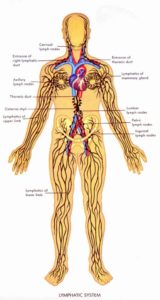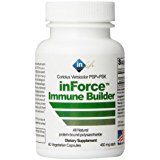Lymphatic System
If you really want to dig down into the workings of your Lymphatic System and how immune system works, we’ve put together this semi-layperson’s explanation. It’s not terribly technical, but there are just some things that you can’t “translate” from standard medical terminology.
The lymphatic system consists of two parts, the primary and secondary organs.
Primary Organs
The thymus gland (located beneath the breast bone, and functioning at its peak during adolescence) and the bone marrow produce specialized lymphocytes—T-cells and B-cells and dispatching them through the lymph vessels to the secondary organs.
Secondary Organs
The lymph nodes include the spleen, tonsils, Peyer’s patches in the small intestines, the liver, and the appendix to name a few. These are the locations where the molecular parts of the immune system gather in readiness to do battle with germs, viruses, and allergens.
The thymus gland is the central organ in the development of immune power. Within its cortex, the bone marrow lymphocytes mature into T-cells helped by thymosin, a hormone secreted by the thymus gland.
The main job of bone marrow is to produce both red and white blood cells. It is the source of stem cells which differentiate (change into) leukocytes and lymphocytes.
So, the bone marrow creates the stem cells which become the cells of the immune system. Lymphocytes are sent from the bone marrow to the thymus gland to mature and are then stored in the secondary organs of the lymph system and in the blood stream. The bone marrow also sends leukocytes into the blood stream on sentry duty. Everything now stands in a “combat ready” state.
Cellular components of the system
There are two major cell types of immune system cells (1) phagocytes and (2) lymphocytes. Lymphocytes are small white cells found in lymphoid tissues and are also present in the blood. They get to the blood stream from the lymph nodes, which are small pea sized organs distributed throughout the body. The lymph nodes trap antigens (substances that trigger an immune response) and filter them out of the lymph fluid. The lymph fluid is actually tissue fluids that have been collected from throughout the body for cleaning, and then are returned to the blood stream via lymphatic vessels.
Lymphocytes
There are two types of lymphocytes: T-cells and B-cells.
-
-
- Helper T-cells (their quantity being a CD4 count)
- Suppressor T-cells (their quantity being a CD8 count)
- Effector T-cells (sometimes referred to as natural killer, or NK, cells)
-
T-cells are the master regulators of the immune system. There are three main types of T-cells:
Helper T-cells stimulate B-cell production and augment production of more helper cells and effector cells (natural killer cells). Suppressor T-cells act to diminish helper T-cell activity, for let’s face it, when the battle is over, we don’t want the immune system to keep on fighting.
Normally there are about twice as many helper T-cells as suppressor T-cells. In immune deficiency diseases, such as AIDS, you will often hear about the CD4 count falling below the CD8 count. What they are talking about is the helper/suppressor ratio getting out of whack. When this occurs, the body is ripe for an “opportunistic infection.”
B-Cells
B-cells have a relatively short life span compared to T-cells. As B-cells mature, they turn into antibody-producing plasma cells found in lymph nodes and in the spleen. Once the B-cells have created a specific antibody to attack a specific pathogen, their primitive intelligence remembers this information and will know it later should they run up against the same pathogen. This is what occurs when you “build resistance.”
NK Cell Activity
Let’s take a look at NK Cell Activity. It is the primary criteria determining the overall strength and health of your immune system. NK cells are not, like white blood cells, measured by their number, for their number stays constant, approximately 15% the number of your white blood cells. NK cells provide the first line of defense in dealing with any invasion to your body once they invaders have passed the sentries in your mucus membranes and the tonsils. Each NK cell contains several small granules that act like tiny explosive charges. When a cancer cell is recognized, the NK cell attaches itself to the cancer cell and injects these granules into the cancer cell and they explode, destroying the cancer cell within five minutes. The NK cell then moves on to another invader. Healthy NK cells have been known to attack two or more invaders or infected cells at once. That’s why having a strong, healthy immune system is key to fighting cancer.
It is now accepted that individuals with low NK cell activity are more susceptible to Chronic Fatigue, autoimmune diseases, cancerous tumors and viral infections.
Phagocytes
Phagocytes (leukocytes) are the second type of immune system cells. Phagocytes ingest other cells, microbes, and foreign particles in a process of phagocytosis (an ability of only a few types of phagocytes). They move like tiny amoebas through the blood stream to the site of an injury where they either destroy the invader themselves, or produce antibodies that can. But note that phagocytes cannot destroy viruses.
The actual destruction of a phagocyte’s target is carried out by the phagocyte releasing strong free radicals (those things that age us that we battle with antioxidants), such as hydrogen peroxide and superoxide anion. Interestingly enough, the phagocyte must contain enough antioxidants to protect itself against its release of free radicals, or each attack will be a Kamikaze attack. Phagocytes store the antioxidants Vitamin C and the amino acid glutathione as protection, though it has been discovered that, in some scenarios, excessive amounts of vitamin C can suppress its cidal capacity (since the free radicals released to destroy a pathogen are quickly cleaned up before they can do their job). Thus, this tiny cell must regulate its own generation of antioxidants and free radicals to enable it to do its job and survive the battle.
There are many types of phagocytes. But they are broken into two groups (1) myeloid cells (granulocytes) and (2) monocytes. The granulocytes are cells filled with granules of toxic chemicals that digest the invaders. Examples of granulocytes are basophils, neutrophils, eosinophils, and mast cells. Monocytes are short-lived phagocytes that become various macrophages found throughout the body whose task it is to clean up the waste produced by the immune system as well as destroy pathogens (disease causing substances). Macrophages (literally “big eaters” in Latin), eventually die (after eating their fill) producing the mucus and pus we find as the result of an infection.
When you are all stuffed up and coughing up phlegm as the result of a cold, these cold symptoms (coughing) are the result of your immune system battling the cold virus (phlegm is dead immune cells). You should note that macrophages require the amino acid L-arginine to create the nitric oxide they use to destroy bacteria, viruses, and cancer cells. Tumors protect themselves by producing the enzyme arginase that breaks down L-arginine.
Every cell in our bodies has receptors, a spot where chemicals can attach themselves to the cells. Our immune system cells have neuropeptide receptors. Neuropeptides are the chemicals released by the brain when we feel good (like happiness) and when we feel bad (from anger and frustration). So, amazing as it sounds, our immune system is actually listening to and is affected by our emotional dialog.
Hybridoma
Finally we should mention hybridoma, a hybrid cell created when a lymphocyte fuses to a cancer cell and secretes either a lymphokine or an antibody specific for just one antigen. Hybridomas are currently being studied in laboratories that use stem cell assay, a process where a biopsy of cancerous tissue is cloned and experimented on. Once it is discovered which antibody the patient’s own immune system wants to create to fight the cancer, that antibody can be injected in large doses back into the patient to battle the cancer. While testing is still incomplete, the indication is that having a strong immune system can be one of the key factors to battling diseases. Sound familiar?
Antibodies
Antibodies are protein molecules, called immunoglobulins—Ig, produced by the B-cells. There are five classes of antibodies: IgA, IgD, IgE, IgG, and IgM. IgA and IgE are referred to as secretory antibodies because they are found in our secretions. IgA is found abundantly in saliva and in the mucous membranes of your lungs, intestinal track, and genitals. It is the first line of defense against invading bacteria. Laboratory studies show increases in IgA output in people enjoying themselves during exercise, laughter, and love making. Laughter is the best medicine.
IgE is our first defense against allergies and parasites. It is thought that as many as half a million IgE molecules can bind to a single mast cell. Mast cells act as sentinels. They trigger a quick response to an invasion of allergens and parasites, and it is the immunoglobulin E that triggers the release of histamines (those things we take antihistamines to suppress). Histamines increase immune response and blood flow.
Antibodies do not destroy the enemy by themselves, but call in complements. Antibodies are Y-shaped and travel through the bloodstream seeking invading bacteria, viruses, and microbes. When an invader is discovered, the antibody seizes it with one of the upper branches of its Y and calls in the complements.
Wrap Up
So, you’ve now learned the solid basics about our immune system. You can see clearly what I said in the very beginning; every cell in your body participates in the immune system at some level. And, if this incredibly complex system is in proper working order, it has the ability to fight off almost anything…all by itself! That’s the way our body was designed.
All we need to do is help it do it’s job.

 GET YOUR FREE BOTTLE OF INFORCE
GET YOUR FREE BOTTLE OF INFORCE